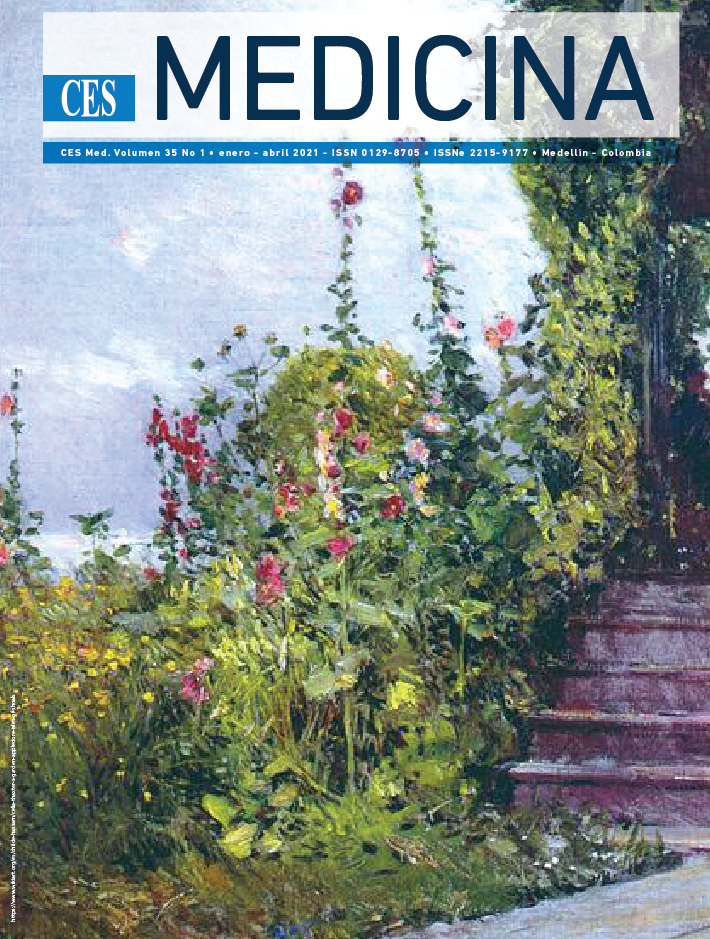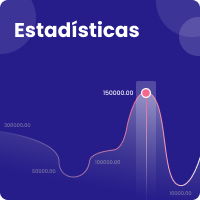Comunicación interventricular post-infarto agudo de miocardio: una complicación inusual pero mortal
DOI:
https://doi.org/10.21615/cesmedicina.35.1.6Palabras clave:
Infarto del miocardio, Defectos del tabique interventricular, Aneurisma cardíacoResumen
Introducción: la revascularización temprana ha reducido la presencia de complicaciones mecánicas del infarto agudo de miocardio; la comunicación interventricular suele ocurrir entre el tercer y quinto día después del infarto. Se presenta el caso de un paciente poco usual y en quien los síntomas predominantes fueron principalmente gástricos.
Descripción: paciente masculino de 65 años, con historia de hipertensión arterial, tabaquismo activo y consumo frecuente de alcohol, quien consultó por síntomas gastrointestinales y dolor torácico de características atípicas. En el examen físico se encontró un soplo holosistólico de predominio en los focos de la base. El electrocardiograma documentó QS en pared inferior, sin alteraciones del segmento ST-T, biomarcadores positivos y el ecocardiograma encontró disfunción sistólica, aneurisma del segmento basal y medio de la pared inferior con comunicación interventricular con flujo de izquierda a derecha. Fue llevado a coronariografía diagnóstica encontrándose enfermedad severa de dos vasos y luego fue intervenido quirúrgicamente para corrección de aneurisma ventricular, comunicación interventricular y bypass coronario.
Conclusión: reconocer las manifestaciones clínicas atípicas del infarto agudo de miocardio y un examen físico bien realizado permiten identificar problemas muy serios, como las complicaciones mecánicas del infarto.
Descargas
Referencias bibliográficas
Ibáñez B, James S, Agewall S, Antunes MJ, Bucciarelli-Ducci C, Bueno H, et al. Guía ESC 2017 sobre el tratamiento del infarto agudo de miocardio en pacientes con elevación del segmento ST. Rev Esp Cardiol. 2017;70(12):1082.e1-1082.e61.
Boletín Observatorio Nacional de Salud. Enfermedad cardiovascular: principal causa de muerte en Colombia. Instituto Nacional de Salud. Boletín No. 1, Diciembre 9 de 2013.
Figueras J, Cortadellas J, Calvo F, Soler-Soler J. Relevance of delayed hospital admission on development of cardiac rupture during acute myocardial infarction: study in 225 patients with free wall, septal or papillary muscle rupture. J Am Coll Cardiol. 1998;32(1):135-9.
Moreno JQ, Rodríguez DJA, Rugeles T, López LMB. Complicaciones mecánicas del infarto agudo de miocardio: aunque infrecuentes, potencialmente letales. Rev Col Cardiol. 2017;24(5):505-9.
Prêtre R, Rickli H, Ye Q, Benedikt P, Turina MI. Frequency of collateral blood flow in the infarct-related coronary artery in rupture of the ventricular septum after acute myocardial infarction. Am J Cardiol. 2000;85(4):497-9, A10.
Kutty RS, Jones N, Moorjani N. Mechanical complications of acute myocardial infarction. Cardiol Clin. 2013;31(4):519-31, vii-viii.
Durko AP, Budde RPJ, Geleijnse ML, Kappetein AP. Recognition, assessment and management of the mechanical complications of acute myocardial infarction. Heart. 2018;104(14):1216-23.
Lemery R, Smith HC, Giuliani ER, Gersh BJ. Prognosis in rupture of the ventricular septum after acute myocardial infarction and role of early surgical intervention. Am J Cardiol. 1992;70(2):147-51.
Crenshaw BS GC, Birnbaum Y, Pieper KS, Morris DC, Kleiman NS, et al. Risk factors, angiographic patterns, and outcomes in patients with ventricular septal defect complicating acute myocardial infarction. GUSTO-I (Global Utilization of Streptokinase and TPA for Occluded Coronary Arteries) Trial Investigators. Circulation. 2000 101(1):27-32.
Honda S, Asaumi Y, Yamane T, Nagai T, Miyagi T, Noguchi T, et al. Trends in the clinical and pathological characteristics of cardiac rupture in patients with acute myocardial infarction over 35 years. J Am Heart Assoc. 2014;3(5):e000984.
Jones BM, Kapadia SR, Smedira NG, Robich M, Tuzcu EM, Menon V, et al. Ventricular septal rupture complicating acute myocardial infarction: a contemporary review. Eur Heart J. 2014;35(31):2060-8.
Moreyra AE, Huang MS, Wilson AC, Deng Y, Cosgrove NM, Kostis JB, et al. Trends in incidence and mortality rates of ventricular septal rupture during acute myocardial infarction. Am J Cardiol. 2010;106:1095-100.
López-Sendón J, Gurfinkel EP, de Sa EL, Agnelli G, Gore JM, Steg PG, Eagle KA, Cantador JR, Fitzgerald G, Granger CB, et al. Factors related to heart rupture in acute coronary syndromes in the global registry of acute coronary events. Eur Heart J. 2010;31(12):1449-1456.
Becker AE, van Mantgem JP. Cardiac tamponade. A study of 50 hearts. Eur J Cardiol. 1975;3(4):349-58.
Smyllie JH, Sutherland GR, Geuskens R, K Dawkins , N Conway , JR Roelandt. Doppler color flow mapping in the diagnosis of ventricular septal rupture and acute mitral regurgitation after myocardial infarction. J Am Coll Cardiol. 1990;15:1449-55.
Arnaoutakis GJ, Zhao Y, George TJ, Sciortino CM, McCarthy PM, Conte JV. Surgical repair of ventricular septal defect after myocardial infarction: outcomes from the Society of Thoracic Surgeons National Database. Ann Thorac Surg. 2012;94(2):436-43; discussion 443-444.
Papalexopoulou N, Young CP, Attia RQ. What is the best timing of surgery in patients with post-infarct ventricular septal rupture? Interact Cardiovasc Thorac Surg. 2013;16(2):193-6.
Menon V, Webb JG, Hillis LD, Sleeper LA, Abboud R, Dzavik V, et al. Outcome and profile of ventricular septal rupture with cardiogenic shock after myocardial infarction: a report from the SHOCK Trial Registry. Should we emergently revascularize Occluded Coronaries in cardiogenic shock? J Am Coll Cardiol. 2000;36(3 Suppl A):1110-6.
Dalrymple-Hay MJ, Monro JL, Livesey SA, Lamb RK. Postinfarction ventricular septal rupture: the Wessex experience. Semin Thorac Cardiovasc Surg. 1998;10:111-6.
Descargas
Publicado
Cómo citar
Número
Sección
Licencia
Derechos de autor 2021 CES Medicina

Esta obra está bajo una licencia internacional Creative Commons Atribución-NoComercial-CompartirIgual 4.0.
Derechos de reproducción (copyright)
Cada manuscrito se acompañará de una declaración en la que se especifique que los materiales son inéditos, que no han sido publicados anteriormente en formato impreso o electrónico y que no se presentarán a ningún otro medio antes de conocer la decisión de la revista. En todo caso, cualquier publicación anterior, sea en forma impresa o electrónica, deberá darse a conocer a la redacción por escrito.
Plagios, duplicaciones totales o parciales, traduccones del original a otro idioma son de responsabilidad exclusiva de los autores el envío.
Los autores adjuntarán una declaración firmada indicando que, si el manuscrito se acepta para su publicación, los derechos de reproducción son propiedad exclusiva de la Revista CES Medicina.
Se solicita a los autores que proporcionen la información completa acerca de cualquier beca o subvención recibida de una entidad comercial u otro grupo con intereses privados, u otro organismo, para costear parcial o totalmente el trabajo en que se basa el artículo.
Los autores tienen la responsabilidad de obtener los permisos necesarios para reproducir cualquier material protegido por derechos de reproducción. El manuscrito se acompañará de la carta original que otorgue ese permiso y en ella debe especificarse con exactitud el número del cuadro o figura o el texto exacto que se citará y cómo se usará, así como la referencia bibliográfica completa.
| Estadísticas de artículo | |
|---|---|
| Vistas de resúmenes | |
| Vistas de PDF | |
| Descargas de PDF | |
| Vistas de HTML | |
| Otras vistas | |



